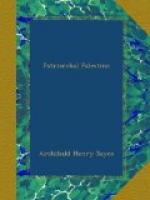Did these Rephaim belong to the same race as the Emim and the Anakim, or were the latter called Rephaim or “Giants” merely because they represented the tall prehistoric population of Canaan? The question can be more easily asked than answered. We know from the Book of Genesis that Amorites as well as Hittites lived at Hebron, or in its immediate vicinity. Abram dwelt in the plain of Mamre along with three Amorite chieftains, and Hoham, king of Hebron, who fought against Joshua, is accounted among the Amorites (Josh. x. 1). The Anakim may therefore have been an Amorite tribe. They held themselves to be the descendants of Anak, an ancient Canaanite god, whose female counterpart was the Phoenician goddess Onka. But, on the other hand, the Amorites at Hebron may have been intruders; we know that Hebron was peculiarly a Hittite city, and it is at Mamre rather than at Hebron that the Amorite confederates of Abram had their home. It is equally possible that the Anakim themselves may have been the stranger element; we hear nothing about them in the days of the patriarchs, and it is only when the Israelites prepare to enter Canaan that they first make their appearance upon the stage.
Og, king of Bashan, however, was an Amorite; of this we are assured in the Book of Deuteronomy (iii. 8), and it is further said of him that he only “remained of the remnant of the Rephaim.” The expression is a noticeable one, as it implies that the older population had been for the most part driven out. And such, in fact, was the case. At Rabbath, the capital of Ammon, the basalt sarcophagus of the last king of Bashan was preserved; but the king and his people had alike perished. Ammonites and Israelites had taken their place.
The children of Ammon had taken possession of the land once owned by the Zamzummim (Deut. ii. 20). The latter are called Zuzim in the narrative of Genesis, and they are said to have dwelt in Ham. But Zuzim and Ham are merely faulty transcriptions from a cuneiform text of the Hebrew Zamzummim and Ammon, and the same people are meant both in Genesis and in Deuteronomy. In Deuteronomy also the Emim are mentioned, and their geographical position defined. They were the predecessors of the Moabites, and like the Zamzummim, “a people great and many and tall,” whom the Moabites expelled doubtless at the same time as that at which the Ammonites conquered the Zamzummim. The “plain of Kiriathaim,” or “the two cities,” must have lain south of the Arnon, where Ar and Kir Haraseth were built.
South of the Emim, in the rose-red mountains of Seir, afterwards occupied by the Edomites, came the Horites, whose name is generally supposed to be derived from a Hebrew word signifying “a cave.” They have therefore been regarded as Troglodytes, or cave-dwellers, a savage race of men who possessed neither houses nor settled home. But it is quite possible to connect the name with another word which means “white,” and to see in them the representatives of a white race. The name of Hor is associated with Beth-lehem, and Caleb, of the Edomite tribe of Kenaz, is called “the son of Hur” (1 Chron. ii. 50, iv. 4). There is no reason for believing that cave-dwellers ever existed in that part of Palestine.




